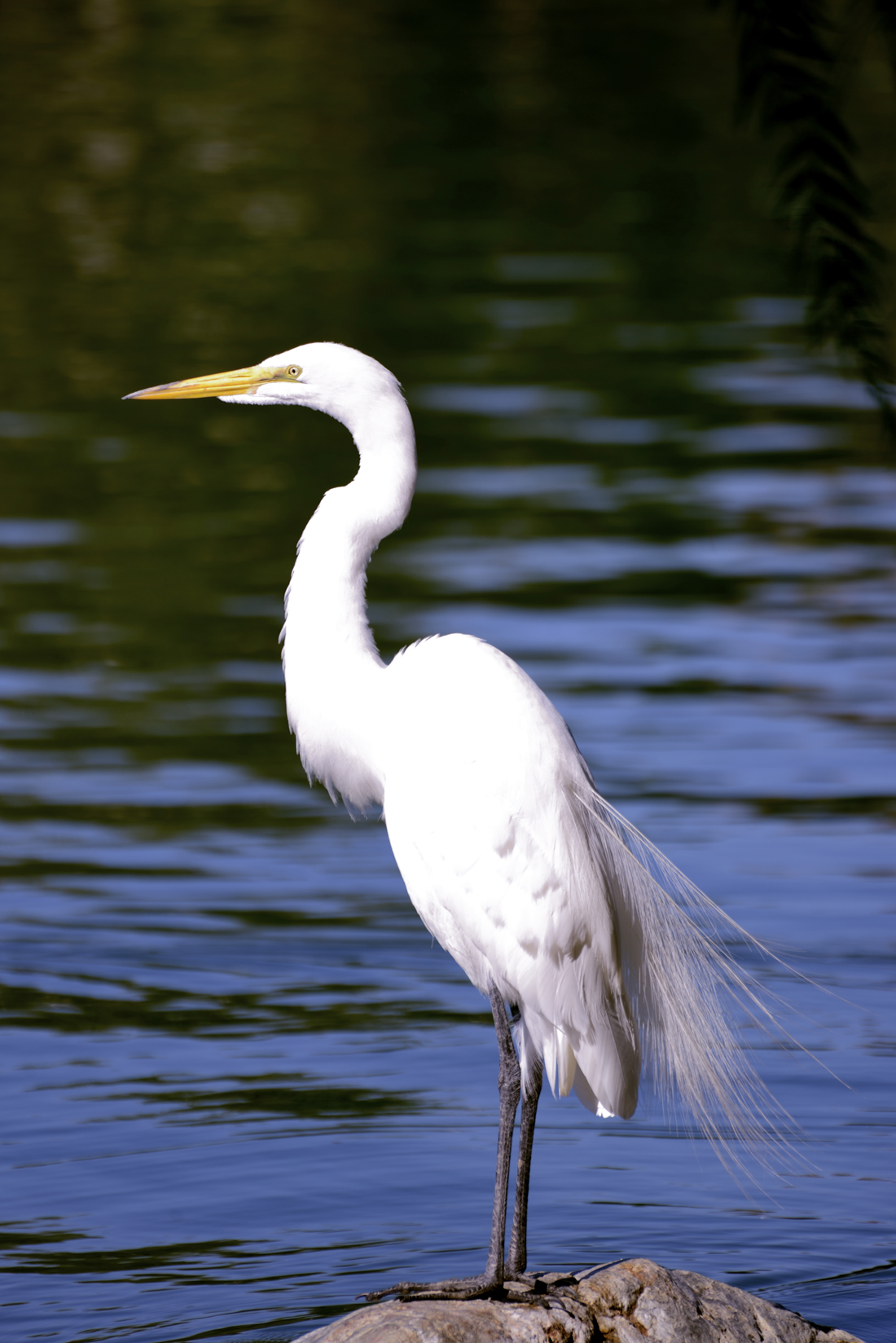Dot Kent has learned a lot about migratory birds the past two years. As neighborhood education director for Fort Worth, she coordinates the efforts of several neighborhood associations and the city to discourage egrets, an internationally protected bird, from nesting in local residents’ trees. As their rural habitat shrinks, the white birds have begun moving into residential neighborhoods to nest, lay eggs, and make a lot of noise. A bunch of egret nests can cover yards in deep doo-doo, leaving homeowners searching for innovative ways to get out from under the problem.
“It’s not exclusively a Fort Worth problem,” said Kent, who will hold a migratory bird workshop on Wednesday, Jan. 22, at the Riverside Community Center to teach techniques for dealing with the unwelcome bird population. “Carrollton is dealing with this too,” she added, referring to an incident in 2011 in which several homes were inundated with as many as 50 nests per tree, leaving one to three inches of fecal matter below.
The trick is to keep the birds from nesting. Once they build nests, the birds can’t legally be driven off.
“The most important thing people can learn at the workshop is how to recognize herons and egrets,” she said. “They are protected under an international treaty. Once an egg is present, you cannot harass the bird.”
Workshop attendees will learn how to recognize egret nests and the intricacies of the international law protecting egrets and other migratory birds. While many locals are alarmed at the recent influx of egrets into residential areas, local naturalists say the invasion isn’t a surprise given the proximity of homes to the birds’ habitat and the large trees that line older neighborhoods.
“Tanglewood is essentially a forest,” said Rick Shepherd, a resident of that area and a master naturalist. “Every time a mall is built, a forest is diminished. If these migratory birds don’t have a [rural] place to nest, then they are going to look elsewhere.”
Shepherd is a member of the Cross Timbers chapter of the Texas Master Naturalist Program, an organization dedicated to the conservation, preservation, and restoration of natural resources and to promoting ecological education. While acknowledging that bird droppings can be a serious health hazard for humans, he sees a need for people to view animals as part of the world we live in.
“When it’s explained like that, people understand, but they don’t necessarily accept it,” he said.
From her position with the city, Kent sees the difficult balancing act between residents and wildlife. “As we grow, expand, and develop, their habitat is being lost,” she said.
“We’re just holding our breath,” said Bill Campbell, Tanglewood Neighborhood Association president, who is hoping that the birds will choose somewhere else to roost. “Two years ago we had three nests [in Tanglewood]. The year after that we expected more problems, so we contacted the Carrollton neighborhood that had dealt with this before. We trimmed our trees and held night and morning vigilance sessions. We even had grandmothers out there with noisemakers.”
Campbell heard numerous horror stories from nearby residents, whose property had been inundated with hundreds of egret nests, leaving their lawns reeking and forcing residents to use umbrellas just to reach their cars.
Last January, he and local residents decided to do something about it.
“We started with a meeting at Central Market,” he said. “It was a concerted effort between the city and residents.”
At the meeting, residents learned prevention techniques like trimming trees so the egrets have fewer branches to build nests on, using air horns to scare off birds, and putting balloons in trees to function as scarecrows. The precautions worked, according to Campbell, who said Tanglewood “didn’t have a lot of infestations last year.”
Dean Williams, a TCU biology professor, isn’t so sure these measures will succeed in the long term. “It may or may not work,” he said, adding that preventions might be effective if they’re done consistently over a long period. “My guess is that [the egrets] will keep returning.”
Williams said that egrets, which are native to the area, have a strong tendency to revisit the same areas year after year.
“There are many misconceptions about these birds,” said Brett Johnson, urban wildlife biologist for Texas Parks and Wildlife. The birds causing problems here, he said, are cattle egrets.
“They are more grassland species than aquatic,” he said. “Their main food source is insects and grasshoppers. The cattle egrets have only been [in North Texas] since 1941. They have been following cattle production. What really attracts them is a mature [tree] canopy.”
Johnson works with cities to identify neighborhoods that are at greatest risk of being targeted by cattle egrets. Since large trees like live oaks take decades to reach full maturity, it means identifying subdivisions built in the 1960s or earlier. Then the city encourages residents to trim their trees and learn ways to scare the birds off.
Egrets are one of more than 800 species protected under the Migratory Bird Treaty Act of 1918, which prohibits people in Russia, Mexico, the United States, and Japan from harming any bird listed in the act, whether they are endangered or not. Shepherd said the treaty’s creation was prefigured by birds that were being over-hunted for their feathers. “The problem started back in the early 20th century, when feathers were used for décor, and the birds started diminishing,” he said.
He explained that cattle egrets expanded their range into North America to fill a niche in the ecosystem.
The act does not prohibit discouraging birds from nesting by making loud noises or changing the landscape to prevent them from roosting. But once the nest is built, then there’s probably an egg, Shepherd said, and from that point on until the birds depart, they must be left alone.
The act leaves city officials and residents with a limited but creative array of defenses. The city’s website says nesting season for egrets begins in March and ends in October. During this time property owners cannot “kill, harass, relocate, move, or attempt to scare away birds.”
The city recommends that between November and February every year, property owners destroy old nests, thin tree canopies, and use “scaring devices” before the egrets lay eggs. Any dead egrets are supposed to be reported to animal care and control –– the migratory bird act forbids members of the general public to handle the birds, dead or alive. Johnson said injured birds can be reported to Rodgers Wildlife Rehabilitation Center in Hutchins.
Kent said she hopes the upcoming community meeting at the Riverside Community Center will build cooperation among various neighborhood associations, the city, and government organizations.
“Helping people connect with each other is what this meeting is about,” she said.
Tanglewood residents said they’re grateful to the city for moving proactively and coordinating the efforts of neighborhood associations. “The city has done an incredible job,” Campbell said.
Johnson said relocation efforts won’t harm the birds. “Keep them moving,” he said. “These birds are highly mobile. They could shift several hundred miles away if they needed. They could easily end up living in Kauffman County, for example.”
City officials don’t seem to have a short-term plan to solve the problem, leaving residents to revisit the situation continuously for the foreseeable future.
“Our parks department is working to identify habitats where they wouldn’t be a nuisance,” Kent said, “but it’s hard to make wild birds do what you want.”
Fort Worth freelance writer Edward Brown can be reached at ejb0017@yahoo.com.













Nice article, Eddie, and well-presented to the reading public. That said, the bird photo is that of a Great Egret, also known by some as a common or American Egret, not a Cattle Egret, which is a much smaller white bird with different markings. The 2012 rookery problem in Tanglewood predominately involved Cattle Egrets, but collectively the rookery involved another 4 species all nesting together.
It was nice speaking with you for this article.
Rick Shepherd
Hey Rick. Thanks for your help. Yes, we all could stand to learn more about our animal neighbors, even their pictures. Thanks for pointing out the correct bird captured in our pic and best wishes in your work. Eddie Brown
Extreme